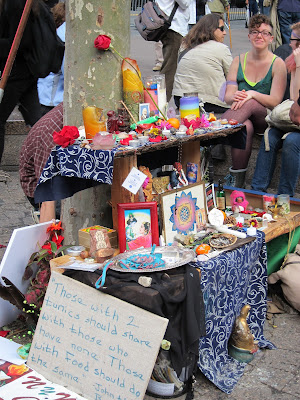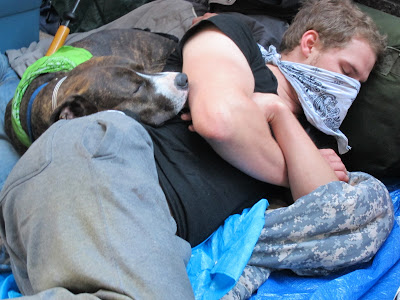Last August, a friend of mine sent me some information on a man from Croatia named Braco (pronounced brot'-so). He apparently heals people just by looking at them or at a photo. Yes, I know, you have a bridge to sell me.
I watched a couple of YouTube testimonials from people in Europe and the United States. Supposedly, there is medical documentation to show that people who had terminal diseases and many other physical or emotional maladies had experienced spontaneous cures after a gazing session with Braco. I found that intriguing.
Braco is 43 years old, married and has a young son. He has long hair, which makes me feel nostalgic for the late sixties. He never sought to be a healer, so the story goes. He had a Master’s degree in economics and had worked previously in the business world.
One day, his mother wanted to see a well-known Croatian healer, Ivica Prokic. Braco thought the man might be a charlatan, so he went with his mother to check the man out. He was so impressed, he quit his day job to work with this healer. Prokic became his mentor and felt that Braco had a natural talent for healing. When Prokic drowned in 1995, people began asking Braco for help. At first, he declined, but the sick kept coming anyway. Through word of mouth only, his following grew. He apparently does not do television or newspaper interviews.
"The doctor of the future will give no medicine, but will interest his patients in the care of the human frame, in diet, and in the cause and prevention of disease."—Thomas Edison, Inventor
I looked up Braco’s website and found that he was appearing at the Sheraton Hotel in East Rutherford, New Jersey in early October. I bought a full-day pass for myself and my husband, Steve, as well as a one-session pass the next day for Steve, myself and our two daughters (who know—eyes rolling—that Mom is into new and interesting experiences).
One thing that impressed me about Braco was how inexpensive his sessions were. At a cost of $8 per session, anyone can afford to see him. In one session, Steve and I sat next to two Roman Catholic nuns dressed in full habits. People came from as far as California, Florida, Puerto Rico and Europe to attend these sessions in New Jersey.
I decided that the best way to get my money’s worth was to bring photos of every member of my family, plus my personal trainer (who’s having some health issues) and a young man I used to work with who is suffering from an invasive brain tumor. I did not tell him I was doing this. People who are seriously ill can get offended if they think you are trying to be “helpful.” But he has a wife and two young children, so I decided there was no harm in taking his photo and not telling him.
I’m not sure what I expected. My husband is very good at sensing energy, while I am energy-deaf, so to speak.
"The art of healing comes from nature and not from the physician. Therefore, the physician must start from nature with an open mind."—Paracelsus
So we sat in the first session. Steve saw an aura of white around Braco and was overpowered by the energy surging out of him. Not much happened for me. The second session, Steve had another dramatic episode; every cell in his body was tingling. Not much happened for me.
Then I told Steve for the next session, I would close my eyes. I know you’re supposed to look into Braco’s eyes, but that just wasn’t working for me. With my eyes open, I’m too easily distracted. There were, after all, shiny objects in the room. So on the third session, Steve again experienced heat, vibrations and mind-blowing energy waves. With my eyes closed, I felt a warm surge of contentment, maybe even a mild floating sensation. It was a beginning. We had four more sessions. Steve was almost levitating after one of them. My reactions were more low-key. One thing I did notice—and I hope it remains. My legs and one hand have been swollen for quite some time. By the end of the evening, most of the swelling was gone.
It’s said that many of the effects of a session with Braco take weeks to manifest. So now, I needed to sit back and see if anything would change for either one of us or the people whose pictures we’d held during the sessions.
The day after the session, I visited my mother, as I do every Sunday. I asked her how she was feeling, as I always do. She said she felt better than she had in a long time; that her health had gone up a level. Normally, she just smiles at me and says, "I'm fine." I never told my mother about Braco as she would most likely laugh at me and shake her head.
I can't speak for my daughters. They both think that energy healers are crap.
"Quantum physics has found that there is no empty space in the human cell, but it is a teeming, electric-magnetic field of possibility or potential.”—Dr. Deepak Chopra
Steve has not taken his fibromyalgia medication since the session—which at this point is almost a month ago. (He has had fibromyalgia for 11 years and has depended on that medication to function.) He also has not experienced any migraines since the session; usually a daily occurrence for him. And I can touch him on the shoulders and back, normally a no-no for someone who has fibro-sensitive nerve endings. As for myself, the more noticeable swelling has not come back, although my ankles are still a bit puffy.
Is Braco a gifted healer or a con artist? That's hard to say. But at $8 a session, who cares? It can't hurt.
I watched a couple of YouTube testimonials from people in Europe and the United States. Supposedly, there is medical documentation to show that people who had terminal diseases and many other physical or emotional maladies had experienced spontaneous cures after a gazing session with Braco. I found that intriguing.
 |
| Over 250,000 people have seen Braco. |
One day, his mother wanted to see a well-known Croatian healer, Ivica Prokic. Braco thought the man might be a charlatan, so he went with his mother to check the man out. He was so impressed, he quit his day job to work with this healer. Prokic became his mentor and felt that Braco had a natural talent for healing. When Prokic drowned in 1995, people began asking Braco for help. At first, he declined, but the sick kept coming anyway. Through word of mouth only, his following grew. He apparently does not do television or newspaper interviews.
"The doctor of the future will give no medicine, but will interest his patients in the care of the human frame, in diet, and in the cause and prevention of disease."—Thomas Edison, Inventor
I looked up Braco’s website and found that he was appearing at the Sheraton Hotel in East Rutherford, New Jersey in early October. I bought a full-day pass for myself and my husband, Steve, as well as a one-session pass the next day for Steve, myself and our two daughters (who know—eyes rolling—that Mom is into new and interesting experiences).
One thing that impressed me about Braco was how inexpensive his sessions were. At a cost of $8 per session, anyone can afford to see him. In one session, Steve and I sat next to two Roman Catholic nuns dressed in full habits. People came from as far as California, Florida, Puerto Rico and Europe to attend these sessions in New Jersey.
 |
| Braco was born in Zagreb, the capitol of Croatia. |
I’m not sure what I expected. My husband is very good at sensing energy, while I am energy-deaf, so to speak.
"The art of healing comes from nature and not from the physician. Therefore, the physician must start from nature with an open mind."—Paracelsus
So we sat in the first session. Steve saw an aura of white around Braco and was overpowered by the energy surging out of him. Not much happened for me. The second session, Steve had another dramatic episode; every cell in his body was tingling. Not much happened for me.
Then I told Steve for the next session, I would close my eyes. I know you’re supposed to look into Braco’s eyes, but that just wasn’t working for me. With my eyes open, I’m too easily distracted. There were, after all, shiny objects in the room. So on the third session, Steve again experienced heat, vibrations and mind-blowing energy waves. With my eyes closed, I felt a warm surge of contentment, maybe even a mild floating sensation. It was a beginning. We had four more sessions. Steve was almost levitating after one of them. My reactions were more low-key. One thing I did notice—and I hope it remains. My legs and one hand have been swollen for quite some time. By the end of the evening, most of the swelling was gone.
It’s said that many of the effects of a session with Braco take weeks to manifest. So now, I needed to sit back and see if anything would change for either one of us or the people whose pictures we’d held during the sessions.
The day after the session, I visited my mother, as I do every Sunday. I asked her how she was feeling, as I always do. She said she felt better than she had in a long time; that her health had gone up a level. Normally, she just smiles at me and says, "I'm fine." I never told my mother about Braco as she would most likely laugh at me and shake her head.
I can't speak for my daughters. They both think that energy healers are crap.
"Quantum physics has found that there is no empty space in the human cell, but it is a teeming, electric-magnetic field of possibility or potential.”—Dr. Deepak Chopra
Steve has not taken his fibromyalgia medication since the session—which at this point is almost a month ago. (He has had fibromyalgia for 11 years and has depended on that medication to function.) He also has not experienced any migraines since the session; usually a daily occurrence for him. And I can touch him on the shoulders and back, normally a no-no for someone who has fibro-sensitive nerve endings. As for myself, the more noticeable swelling has not come back, although my ankles are still a bit puffy.
Is Braco a gifted healer or a con artist? That's hard to say. But at $8 a session, who cares? It can't hurt.













































